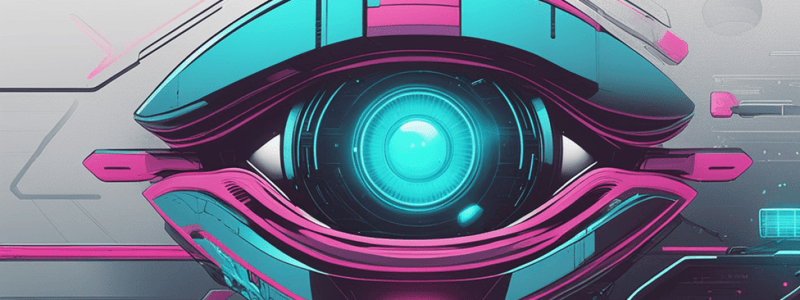Podcast
Questions and Answers
What are the three planes in which the human eye can move?
What are the three planes in which the human eye can move?
Vertical plane, horizontal plane, and circular plane
How does the brain interpret the image sent by the retina?
How does the brain interpret the image sent by the retina?
The optical area of the brain interprets it as an upright one.
What two eye defects can be identified in vision due to the eye ball becoming short or long?
What two eye defects can be identified in vision due to the eye ball becoming short or long?
Long sight (hypermetropia) and short sight (myopia)
How can the defect of short sight (myopia) be corrected?
How can the defect of short sight (myopia) be corrected?
What is binocular vision?
What is binocular vision?
Describe stereoscopic vision.
Describe stereoscopic vision.
What is a cataract?
What is a cataract?
What is glaucoma and what can cause it?
What is glaucoma and what can cause it?
What are some precautionary measures to prevent eye health problems?
What are some precautionary measures to prevent eye health problems?
Why is it important to detect glaucoma at an early stage?
Why is it important to detect glaucoma at an early stage?
What is the correct relationship between the curvature of the eye lens and the focal length for a distant object?
What is the correct relationship between the curvature of the eye lens and the focal length for a distant object?
What type of lens is used to correct the defect of short sight (myopia)?
What type of lens is used to correct the defect of short sight (myopia)?
Why does a person with long sight (hypermetropia) have difficulty seeing close objects clearly?
Why does a person with long sight (hypermetropia) have difficulty seeing close objects clearly?
In which type of lenses is the focal length relatively low?
In which type of lenses is the focal length relatively low?
What is the primary function of binocular vision?
What is the primary function of binocular vision?
Which of the following is a common cause of cataract?
Which of the following is a common cause of cataract?
What is the primary reason for the gradual reduction of the visual range in glaucoma?
What is the primary reason for the gradual reduction of the visual range in glaucoma?
Why is it important for a person with diabetes to be vigilant about developing glaucoma?
Why is it important for a person with diabetes to be vigilant about developing glaucoma?
What is the significance of detecting glaucoma at an early stage?
What is the significance of detecting glaucoma at an early stage?
How does binocular vision contribute to stereoscopic vision?
How does binocular vision contribute to stereoscopic vision?
what is image distance?
what is image distance?
what part of the brain interprets it as an upright image?
what part of the brain interprets it as an upright image?
what are the three layers seen in the eye?
what are the three layers seen in the eye?
how can we clearly see an object close by or far away?
how can we clearly see an object close by or far away?
The eyes of a human, monkey, chimpanzee, gorilla and lorris are located in the front portion of the skull.
The eyes of a human, monkey, chimpanzee, gorilla and lorris are located in the front portion of the skull.
what is binocular vision?
what is binocular vision?
glaucoma is mostly due to?
glaucoma is mostly due to?
The damage caused by glaucoma to the eye can be reversed.
The damage caused by glaucoma to the eye can be reversed.
Flashcards are hidden until you start studying
Study Notes
Eye Movement and Anatomy
- The human eye can move in three planes: horizontally, vertically, and rotationally.
- The eye has three layers: sclera, choroid, and retina.
Vision and Image Interpretation
- The brain interprets the image sent by the retina as an upright image in the occipital lobe.
- The image distance is the distance between the lens and the image formed.
Eye Defects and Corrections
- Short sight (myopia) occurs when the eyeball is too long, and can be corrected with concave lenses.
- Long sight (hypermetropia) occurs when the eyeball is too short, and can be corrected with convex lenses.
- A person with long sight has difficulty seeing close objects clearly.
Binocular Vision and Stereoscopic Vision
- Binocular vision is the ability to use both eyes together to see the world.
- Stereoscopic vision is the ability to see the world in 3D due to the difference in images between the two eyes.
- Binocular vision contributes to stereoscopic vision by allowing the brain to calculate depth cues.
Eye Disorders
- A cataract is a clouding of the lens in the eye that affects vision.
- Glaucoma is a condition that damages the optic nerve, often due to increased pressure in the eye.
- Glaucoma can cause a gradual reduction of the visual range if left untreated.
Prevention and Importance of Early Detection
- Precautionary measures to prevent eye health problems include regular eye checks and protecting eyes from injury.
- Early detection of glaucoma is important to prevent irreversible damage to the optic nerve.
- People with diabetes should be vigilant about developing glaucoma due to increased risk.
Lens and Focal Length
- The curvature of the eye lens should be such that the focal length is equal to the distance of the object.
- Concave lenses are used to correct short sight, and convex lenses are used to correct long sight.
- Convex lenses have a relatively low focal length.
Studying That Suits You
Use AI to generate personalized quizzes and flashcards to suit your learning preferences.




